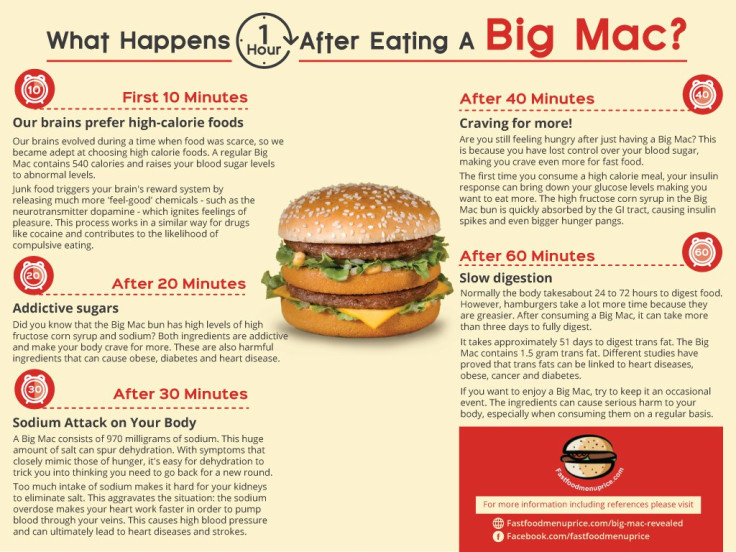The effect a McDonald's Big Mac has immediately after you eat it [Infographic]

An infographic has set out to show just how much our body suffers in the hour after you eat one of McDonald's Big Mac burgers, if bought from the US. Things start off looking fairly positive in the first 10 minutes of eating one – aside from the sudden surge in blood sugar levels – the junk food activates the reward system in our brain, which releases chemicals like neurotransmitter dopamine that make us feel happier.
However, after 20 minutes, things start to get bad. The high levels of high fructose corn syrup and sodium in the iconic burger's buns start to make us crave more as we lose that feeling of being satiated. Additionally, both ingredients contribute to obesity, diabetes and heart disease.
After half an hour, the "huge amount" of sodium – 970 milligrams – begins to wreak havoc. The high salt levels can make you dehydrated, which in turn can add to the cravings. Also, the large amount of sodium makes it difficult for the kidneys to digest salt, which makes the heart work faster, according to the infographic (below) from Fast Food Menu Price – a US-based website dedicated to fast food prices across the globe.
Some 40 minutes after the Big Mac is eaten, you have lost control of the blood sugar, which makes you want more fast food due to the body's insulin response lowering glucose levels. Finally, the infographic explains that it can take up to three days to fully digest the sandwich.
It continues: "It takes approximately 51 days to digest trans fat. The Big Mac contains 1.5g trans fat. Different studies have proved that trans fats can be linked to heart diseases, obese, cancer and diabetes."

IBTimes UK contacted McDonald's UK for comment, which said the ingredients for the Big Mac in the infographic – which originates from the US – are unrecognisable.
A spokesperson said: "The so-called facts in this image are misleading and bear no resemblance to the Big Mac available to customers in the UK. We have been displaying nutritional information for all of our menu items for over 30 years so it is a shame to see such inaccurate figures and information being circulated.
"We have removed all artificial trans fat from our menu, the iconic Big Mac contains no artificial colours or flavours and the bun does not contain any corn syrup. For over 10 years we have been evolving our recipes to reduce salt and sugar, reducing the sugar content of our Big Mac by more than 22%.
"We would encourage our customers to visit the accurate nutritional information section available on our website or mobile phone app to help them make informed choices about their food."
IBTimes UK has reached out to McDonald's US and is awaiting comment.
© Copyright IBTimes 2025. All rights reserved.






















